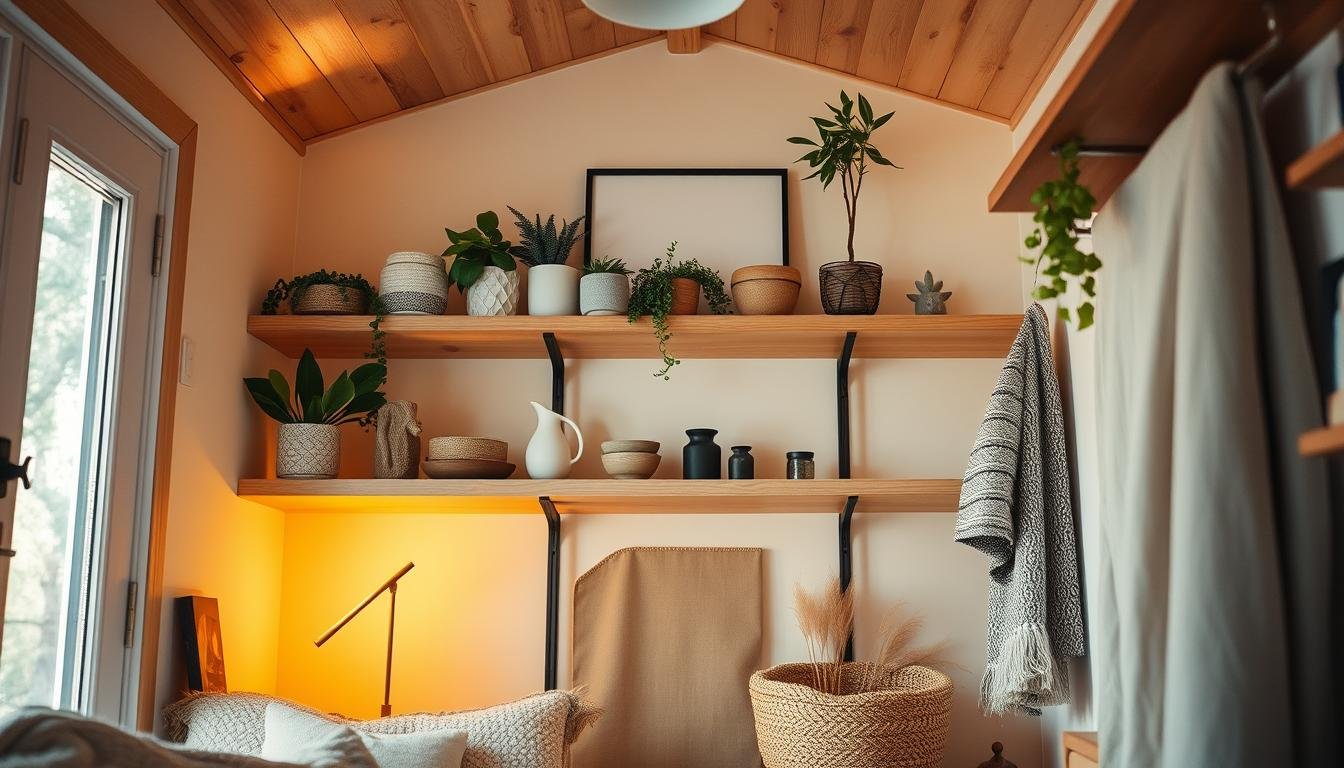Small Space? No Problem! 20 Genius Decor Hacks for Tiny Homes
Are you wondering if it’s possible to create a comfortable and stylish home in a tiny space? With the rising popularity of tiny homes, many are discovering the challenges of living in a compact space. While tiny home living offers numerous benefits, such as being eco-conscious and cost-effective, it also requires careful planning and creative storage solutions.
Living in a small space doesn’t mean you have to sacrifice style or functionality. With the right decor ideas, you can transform your tiny home into a cozy and efficient living area.
This article will explore 20 innovative decor solutions designed to maximize your small space, making it feel more spacious and comfortable.
Key Takeaways
- Creative ways to maximize storage in tiny homes
- Stylish decor ideas for small spaces
- Tips for maintaining functionality in compact homes
- Solutions for transforming small areas into comfortable living spaces
- Ideas for making the most of your tiny home’s layout
The Challenges and Benefits of Tiny Home Living
The tiny home lifestyle is not just about downsizing; it’s about living intentionally and making every inch count. As you embark on this journey, you’ll discover that it’s as much about the challenges you overcome as the benefits you enjoy.
Why Small Space Living Is Trending
Small space living has become increasingly popular due to its numerous benefits, including reduced environmental impact and lower living costs. Many people are drawn to the idea of living more simply and sustainably, and tiny homes offer a unique opportunity to do just that. By embracing this lifestyle, you’re not only reducing your carbon footprint but also creating a more organized and clutter-free living space.
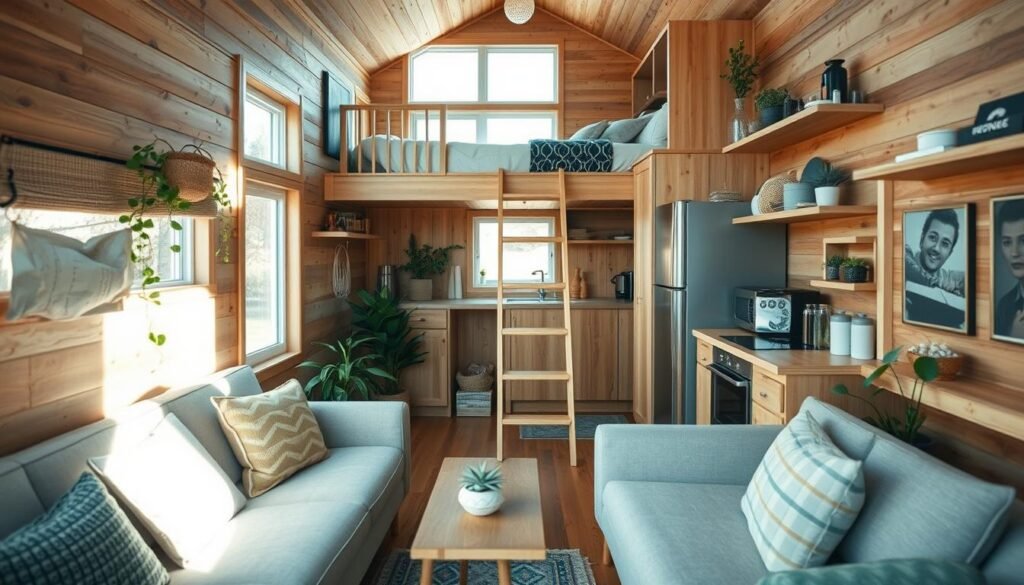
The Art of Maximizing Every Square Inch
To truly make the most of tiny home living, it’s essential to understand the concept of spatial efficiency. This involves more than just downsizing; it’s about creating a functional and comfortable living space that meets your needs. Here are some key strategies to consider:
- Spatial efficiency is about intentional design, where every inch matters, and every element serves a purpose.
- The principle of “zoning” helps create distinct areas for different activities, making the most of your limited space.
- Vertical thinking is crucial when floor space is limited, and using wall-mounted storage solutions can be a game-changer.
- The concept of “negative space” reminds us that it’s okay to leave some areas uncluttered, creating a more peaceful living environment.
- Proper planning before building or moving into a tiny home is vital to maximize functionality and make your home feel more make home comfortable.
- Maximizing space isn’t just about fitting more things in; it’s about creating a comfortable, uncluttered environment that feels like home.
- Professional tiny home designers approach space planning with creativity and practicality, offering valuable lessons for homeowners.
By incorporating these strategies and being mindful of your storage needs, you can create a tiny home that is both functional and beautiful, with ample ways to enjoy your living space.
Multi-Functional Furniture: Double the Function, Half the Space
Multi-functional furniture is a game-changer for tiny homes, allowing you to have the functionality you need without sacrificing space.
When it comes to tiny home living, every square inch counts. One of the most effective ways to maximize space is by incorporating multi-functional furniture pieces that serve more than one purpose.
Sofa Beds That Don’t Sacrifice Style
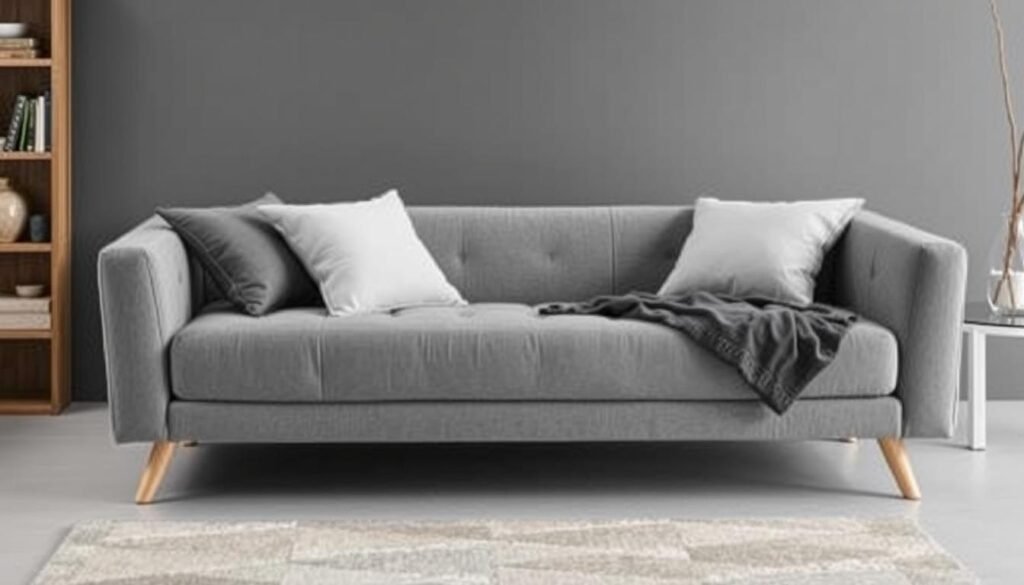
Sofa beds are a staple in many tiny homes, providing a comfortable seating area by day and a cozy bed by night. The key is finding a sofa bed that doesn’t compromise on style.
Look for sleek designs and materials that complement your existing decor. Consider a sofa bed with storage drawers or shelves to further enhance its functionality.
Storage Ottomans: Seating, Table, and Storage in One
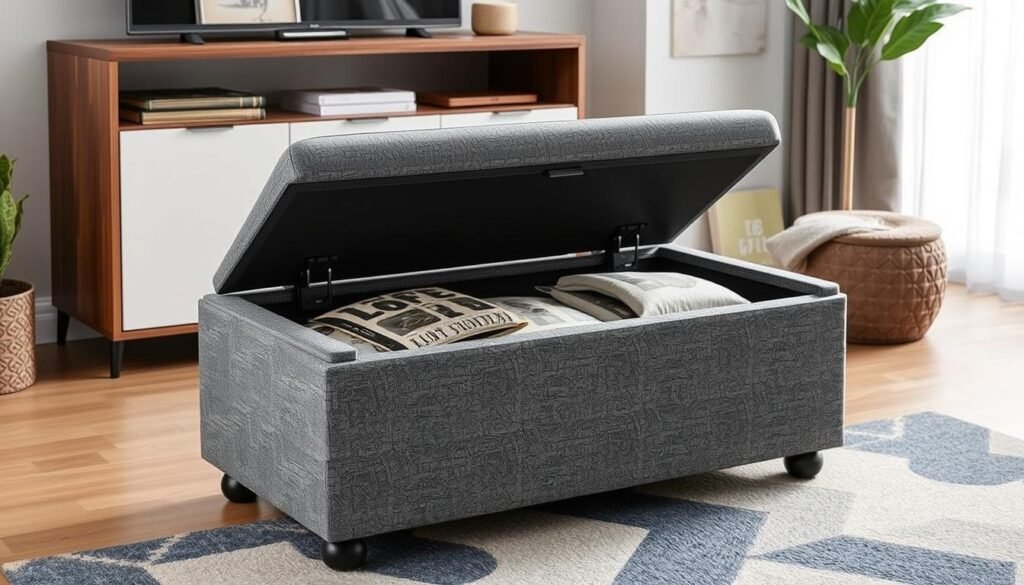
Storage ottomans represent the perfect trifecta of tiny home furniture: seating, table surface, and hidden storage. An ottoman with built-in storage can serve as a footrest, a coffee table with a tray on top, and a hidden storage unit for books, blankets, or kids’ toys.
When choosing a storage ottoman, consider the size and shape that best fits your space. Different sizes and shapes are available, from compact cubes to larger rectangular models.
Here are some creative ways to use storage ottomans:
- Use them as a coffee table by placing a tray on top.
- Store items like throw blankets, pillows, or board games.
- Choose nesting ottomans that can be separated for additional seating when guests visit.
- Select durable materials that can withstand heavy use.
To style your storage ottoman, consider adding a tray to create a stable surface, or use it as a footrest and add a few decorative pillows. You can also use ottomans to add color, texture, and pattern to your space while maintaining functionality.
Go Vertical: Wall-Mounted Storage Solutions
To keep your tiny home organized and spacious, consider leveraging the often-underused vertical space with wall-mounted storage. This approach not only maximizes your living area but also adds a touch of elegance to your decor.
Floating Shelves for Books and Decor
Floating shelves are a fantastic way to add storage for your books, decorative items, and other knick-knacks without cluttering your floor space. When choosing floating shelves for small spaces, consider the material, size, and style to ensure they complement your existing decor.
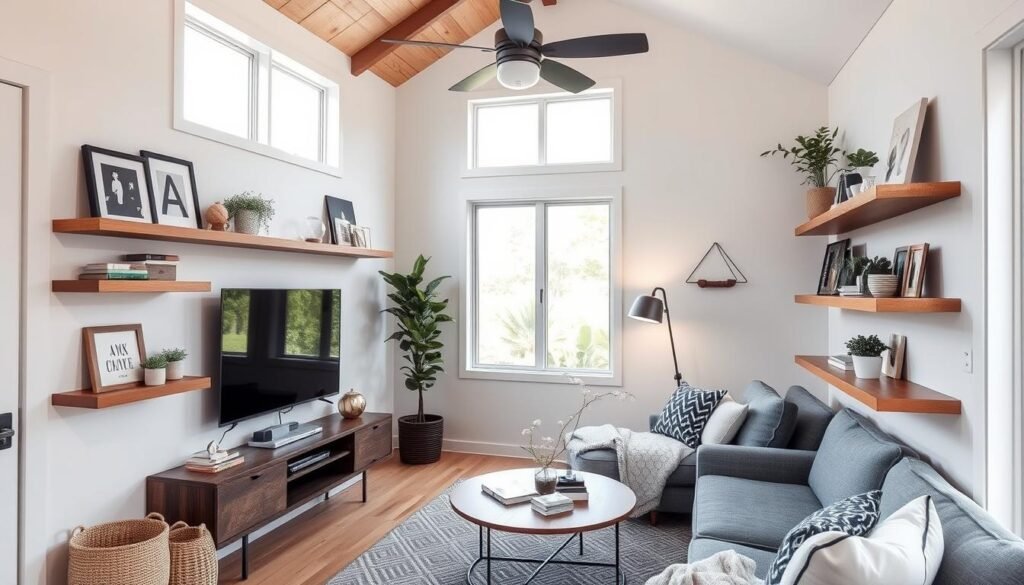
For a seamless look, you can opt for sleek, minimalist designs that blend with your walls. Additionally, using floating shelves of varying lengths can add visual interest to your walls.
Wall-Mounted Desks for Home Office Needs
For those who work from home, a wall-mounted desk can be a lifesaver. Not only does it save floor space, but it also helps in creating a dedicated workspace without compromising on style. Look for wall-mounted folding desks that can be easily tucked away when not in use.
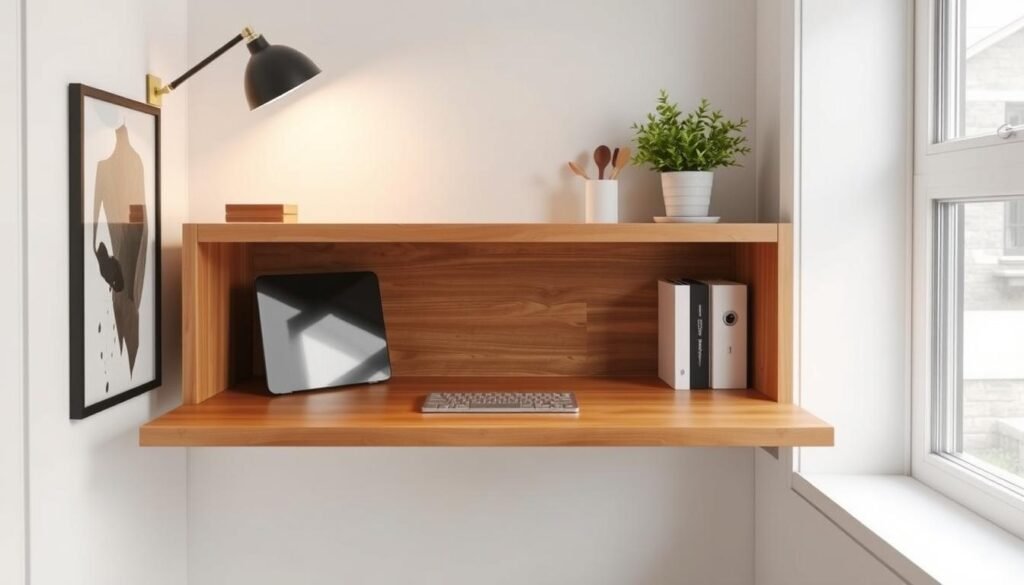
This type of desk is perfect for tiny homes as it offers flexibility and functionality. You can choose from a variety of designs, from modern to traditional, to match your home’s aesthetic.
Pegboards for Versatile Organization
A wall-mounted pegboard is a versatile and affordable way to organize anything from kitchen utensils to office supplies and even jewelry. The best part? You can easily rearrange hooks and baskets to fit your needs.
- Pegboards are highly adaptable and can be used in various rooms, including the kitchen, home office, closet, and garage.
- They allow for frequent reorganization as your needs change, unlike fixed storage solutions.
- Different materials and styles of pegboards are available, from traditional hardboard to modern metal options.
- A wide range of accessories is available for pegboards, and choosing the right ones can enhance their functionality.
- Pegboards can be used creatively beyond the traditional workshop application.
- With the right design, pegboards can look intentional and stylish rather than utilitarian.
- Color and customization options can make pegboards blend with or enhance your decor.
- Tips for organizing different types of items on pegboards can maximize efficiency and visual appeal.
By incorporating these wall-mounted storage solutions, you can significantly enhance the functionality and aesthetic appeal of your tiny home, making the most of your space and adding a touch of elegance to your decor with a clever use of the wall.
Smart Kitchen Hacks for Tiny Homes
In the kitchen of your tiny home, every inch counts, and finding the right storage solutions can make all the difference. With a few clever hacks, you can maximize your kitchen’s efficiency and keep it organized.
Magnetic Spice Tins and Skinny Spice Shelves
Storing numerous small spice containers in a tiny kitchen can be a challenge. One effective solution is using magnetic spice tins. These tins can be attached to the sides of your refrigerator or range hood, utilizing otherwise unused space.
Magnetic spice storage is not only practical but also offers a range of options. You can choose from pre-made magnetic tins or opt for DIY solutions, depending on your preference and skill level. To keep your spices organized, consider implementing a labeling system that is both functional and aesthetically pleasing.
Skinny spice shelves are another great option for tiny kitchens. They can fit into narrow spaces that wouldn’t accommodate standard shelving, providing a perfect place for your spice collection. You can also explore creative locations for spice storage, such as inside cabinet doors or on narrow wall sections.
Visible spice storage can become a colorful design element in your tiny kitchen. By organizing your spices in a logical and visually appealing manner, you can enhance your cooking efficiency while adding to the kitchen’s aesthetic.
Hanging Pots and Pans to Free Up Cabinet Space
Another effective kitchen hack is hanging your pots and pans. This not only frees up valuable cabinet space but also keeps your cookware within easy reach.
Pull-Out Cabinets for Easy Access
Pull-out cabinets are a game-changer for tiny kitchens. They provide easy access to stored items, making it simpler to maintain a clutter-free kitchen.
Bathroom Space-Savers That Make a Big Difference
Maximizing bathroom space in tiny homes requires creativity and the right hacks. You can transform your bathroom into a functional and comfortable oasis with a few simple changes.
Rolled Towels Instead of Folded Ones
One simple trick to save space in your tiny home bathroom is to roll your towels instead of folding them. This not only reduces clutter but also adds a touch of elegance to your bathroom decor. Rolled towels take up less space, allowing you to store more in a smaller area.
Shower Dispensers Instead of Bottles
Switching to shower dispensers is another effective way to save space in your bathroom. These dispensers can be wall-mounted, reducing clutter and keeping your shower floor clear. They are also convenient and can be used for various products, from shampoo to body wash.
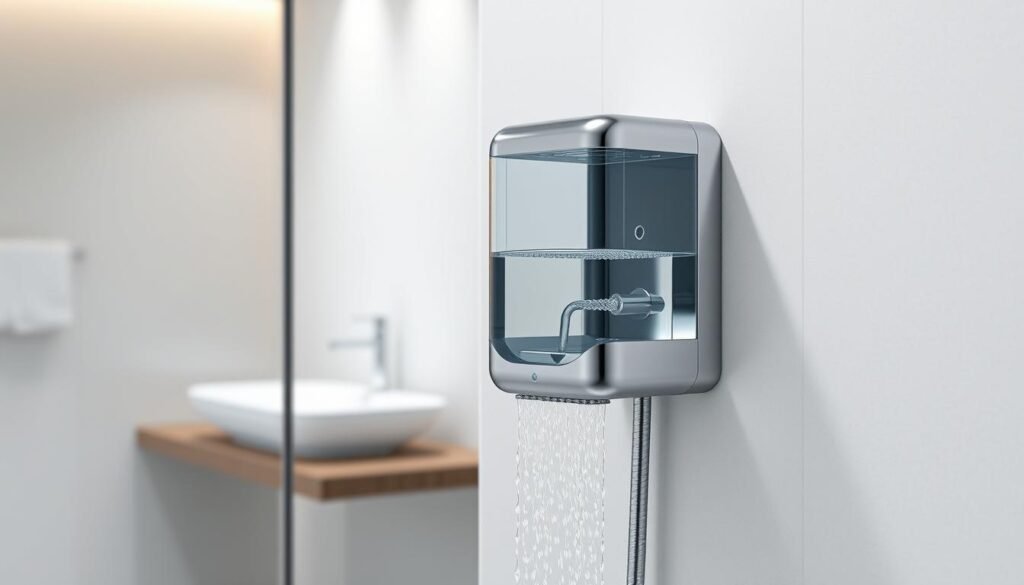
Shower Seats with Storage Underneath
Shower seats are not just a comfort feature; they can also provide valuable storage space. By choosing a shower seat with storage underneath, you can keep your bathroom essentials within easy reach while keeping the floor clear. This is particularly useful in tiny homes where space is at a premium.
When selecting a shower seat, consider the type that best suits your needs. Options range from built-in benches to folding seats and freestanding models. For storage, look for seats with waterproof containers or baskets that can fit underneath, keeping items dry and organized.
Organizing items stored under shower seats is crucial for maintaining a clutter-free bathroom. Use baskets or containers that are designed for wet environments to store items like loofahs, razors, and shower gels. Regularly cleaning the area underneath the seat will prevent mold and mildew, ensuring a hygienic bathroom environment.
Moreover, shower seats can enhance the accessibility of your bathroom, making it safer for everyone, especially the elderly or those with mobility issues. With the right design, a shower seat can also become a stylish element in your bathroom, contributing to its overall aesthetic.
Clever Stairway Storage for Tiny Homes
For tiny home dwellers, turning the stairway into a storage haven can be a game-changer. In addition to providing access between floors, stairways can also serve as a valuable storage space, helping to keep your home clutter-free and organized.
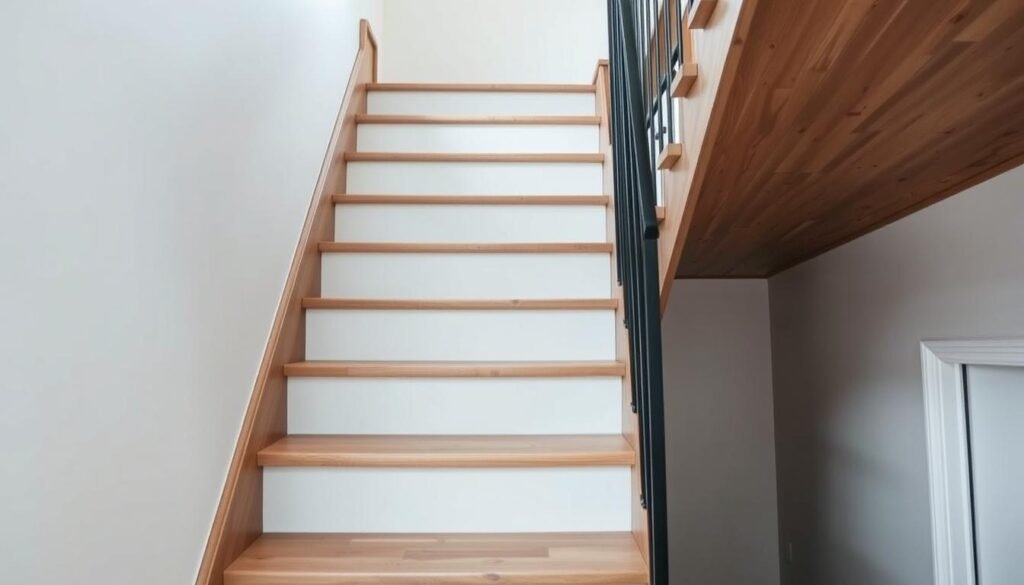
Converting Stairs into Shelving Units
One effective way to utilize the space under your stairs is by converting it into shelving units. This not only adds storage but also creates a visually appealing feature in your home. You can install floating shelves or traditional ones, depending on the design and available space.
When designing your shelving unit, consider the items you plan to store. For frequently used items, make sure they’re easily accessible. For less frequently used items, you can store them on higher or lower shelves.
Hidden Cabinet Space Within Stairs
Beyond shelving, you can also create cabinet storage within your stairs. This involves designing drawers or cabinets that fit snugly under the stair treads, making the most of every inch of available space. This type of storage is perfect for storing items that you don’t need immediate access to, such as seasonal decorations or out-of-season clothing.
To maximize the efficiency of your stairway cabinet storage, consider using dividers or containers to organize the contents. This will help keep items tidy and make the most of the available space. Additionally, think about the door mechanism – options range from traditional hinged doors to more modern push-to-open systems, each offering a different look and feel to your home.
When incorporating storage into your stairway, it’s essential to balance functionality with aesthetics. The design should complement the overall look of your home while providing valuable storage. By doing so, you can create a space that is both beautiful and functional.
Optical Illusions: Making Small Spaces Feel Larger
Transforming tiny homes into spacious havens is easier than you think, thanks to the magic of optical illusions.
Strategic Mirror Placement to Double Visual Space
Using large mirrors in small spaces can create the illusion of a larger area by reflecting light and images, making the room appear more spacious.
To maximize this effect, consider placing a large mirror opposite a window to reflect natural light and the view outside, thus creating a sense of continuity between indoors and outdoors.
Light Colors and Proper Lighting Techniques
Dark walls can make your space feel like a cozy dungeon. Lighter colors, on the other hand, reflect light, making rooms feel airy and open.
Stick to whites, beiges, or pastels for your walls to create a brighter, more spacious feel.
The science behind light colors is simple: they reflect more light, creating the perception of expanded space. Different light hues can also affect spatial perception and mood.
For instance, cool whites can make a space feel larger and more energized, while warm beiges can create a cozier, more relaxed atmosphere.
Layering your lighting is also crucial. Combine ceiling lights, wall sconces, string lights, and under-cabinet lighting to create a well-lit, inviting space.
This layered approach not only enhances the visual appeal but also creates depth and dimension in small spaces.
To further enhance the sense of space, consider the types of lighting: ambient, task, and accent lighting. Ambient lighting provides overall illumination, task lighting focuses on specific areas, and accent lighting highlights architectural features.
By incorporating all three types, you can create a visually interesting and functional space that feels larger than it is.
Maximizing natural light is also essential. Use sheer window treatments and reflective surfaces to bounce natural light around the room, making it feel brighter and more spacious.
In open-concept tiny homes, creating lighting zones can help define different functional areas without the need for physical barriers.
Space-Saving Door Solutions
Maximizing space in tiny homes requires creativity, and one of the most effective strategies involves rethinking the role of doors. Doors are not just entry points; they can also serve as storage units, dividers, or even focal points in a room.
Sliding Doors Instead of Swinging Ones
One of the simplest ways to save space around doors is by switching from traditional swinging doors to sliding doors. This change can significantly impact the flow and functionality of your tiny home.
Sliding doors not only save space by not requiring clearance to swing open, but they can also add a modern touch to your home’s interior. You can opt for sleek, wall-mounted sliding panels or more rustic barn door styles, depending on your decor.
Over-the-Door Storage Organizers
Over-the-door storage is a lifesaver for tiny home dwellers. It’s an accessible and affordable solution for maximizing storage without taking up valuable floor or wall space.
There are various types of over-the-door organizers designed for specific purposes, such as shoe storage, pantry organization, or holding accessories. When selecting over-the-door organizers, it’s crucial to choose quality products that won’t damage your doors or interfere with their operation.
To get the most out of your over-the-door storage, organize your items in a way that balances efficiency with visual appeal. For instance, you can use baskets or bins to keep contents tidy and accessible.
Beyond the obvious locations like closet doors, consider using over-the-door storage in other areas, such as laundry rooms or pantries, to maximize your home’s space.
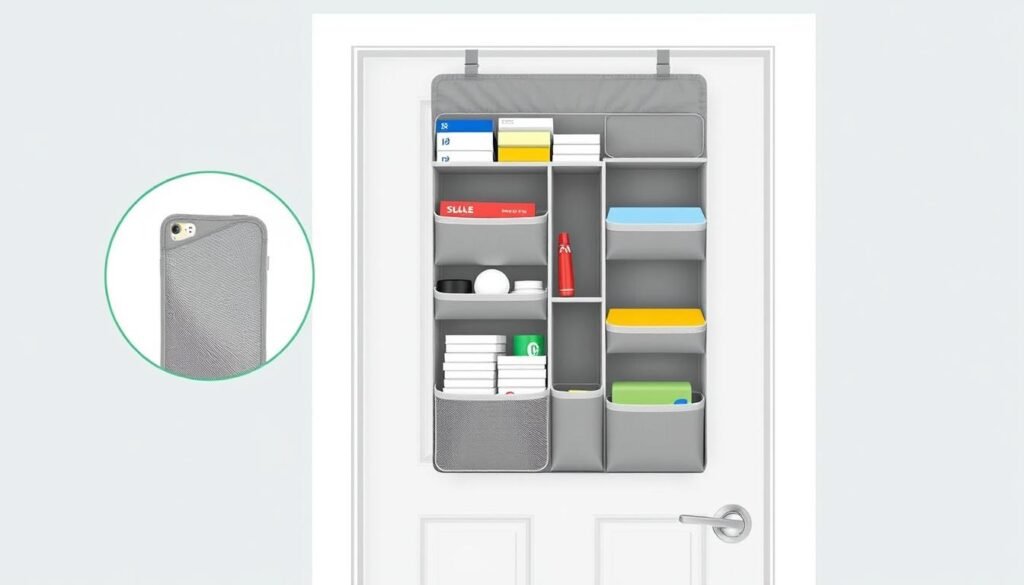
To maintain your over-the-door organizers and prevent sagging or damage, periodically inspect the hooks or brackets and adjust as necessary. You can also customize store-bought organizers to better suit your specific needs.
By integrating over-the-door storage with other storage systems, you can create a cohesive organization approach that makes the most of your tiny home’s space.
Dining Solutions for Tiny Spaces
In tiny homes, the dining space is often a multifunctional area that needs careful planning. You need a space that can serve as a dining area, workspace, and sometimes even a storage area.
Folding and Extendable Dining Tables
Folding and extendable dining tables are perfect for tiny homes as they provide flexibility. When not in use, these tables can be folded up against the wall, freeing up valuable space for other activities.
There are various designs available, from simple folding tables to more sophisticated extendable models that can accommodate additional guests when needed.
Bar Tops for Extra Counter and Dining Space
Bar tops are another innovative solution for tiny homes, offering extra counter and dining space. They can be designed as a peninsula extension of your kitchen counter or as a window-facing ledge, creating a cozy nook.
When designing your bar top, consider its primary function and the seating options. The height of the bar top should be determined based on whether it will be used primarily for dining, working, or as additional counter space for food preparation.
Integrating storage solutions underneath the bar top, such as shelving or cabinets, can enhance its functionality. For seating, you can opt for space-saving stools that tuck underneath or folding chairs that can be easily stored away.
A bar top can also serve as a visual boundary between the kitchen and living areas in open-concept tiny homes, helping to define the different spaces without the need for walls.
To maximize the functionality of your bar top, consider features like built-in outlets or fold-up extensions. Styling your bar top to create an inviting dining experience while maintaining its multi-functional nature is key to a harmonious tiny home design.
For instance, a well-designed bar top can become the heart of your tiny home, where you can enjoy meals, work on projects, or socialize with family and friends.
Living Room Hacks That Maximize Comfort and Space
Your living room is the heart of your home, and with the right hacks, it can be both spacious and comfortable. To achieve this, you need to focus on maximizing storage and comfort without compromising on style.
Sectional Sofas with Built-in Storage
One of the most effective ways to maximize space in your living room is by using sectional sofas with built-in storage. These versatile pieces of furniture provide ample seating while keeping your belongings organized. When shopping for a sectional sofa with storage, consider the size of your room and the style that fits your home decor.
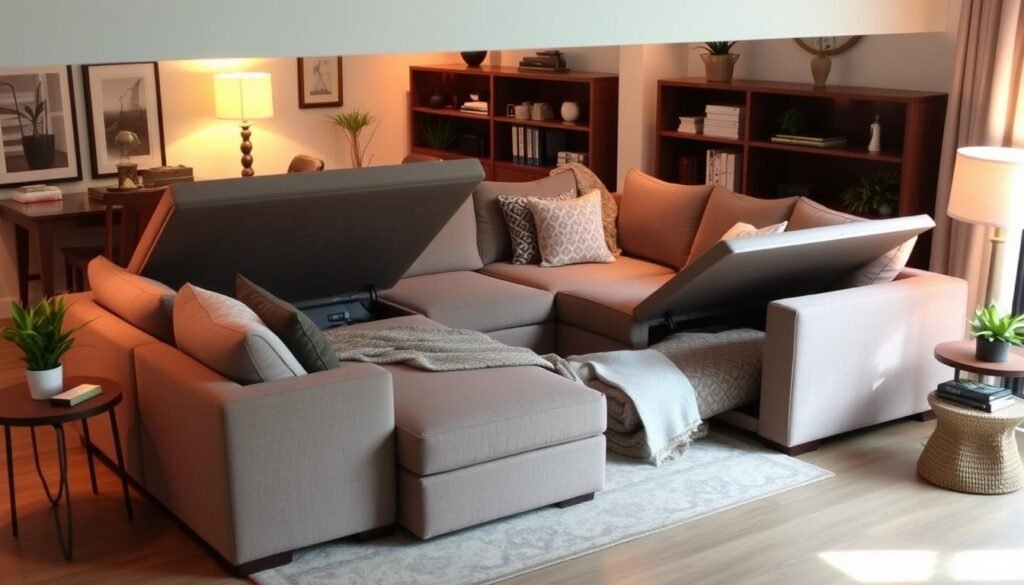
Blanket Ladders for Storage and Style
Not every storage solution has to involve complex DIY projects. Adding a blanket ladder to your living room is a simple yet effective way to gain extra storage and enhance your space’s aesthetic appeal. Blanket ladders are multi-functional pieces that provide storage while adding vertical visual interest to your room.
There are various styles of blanket ladders to choose from, ranging from rustic wood to modern metal designs. You can select a ladder that complements your overall design aesthetic or even DIY one to fit your specific needs.
When placing a blanket ladder, consider strategic locations that maximize both functionality and visual appeal. You can lean it against a wall in a corner or use it as a room divider. Beyond storing blankets, you can use it to display magazines, scarves, or even plants, adding texture and warmth to your space.
To keep your space fresh, you can style your blanket ladder seasonally. This simple switch can refresh your living room without requiring major changes. Moreover, by relocating bulky textiles to a blanket ladder, you can free up valuable drawer or cabinet space, making your living room feel more spacious.
20 Genius Decor Hacks for Tiny Homes: Bedroom Edition
In tiny homes, the bedroom is a sanctuary that requires efficient use of space. To create a serene and functional bedroom, you’ll need to get creative with storage and decor.
Under-Bed Storage Solutions
One of the most effective ways to maximize storage in a tiny home bedroom is by utilizing the space under your bed. Under-bed storage containers are perfect for storing out-of-season clothes, linens, or personal items.
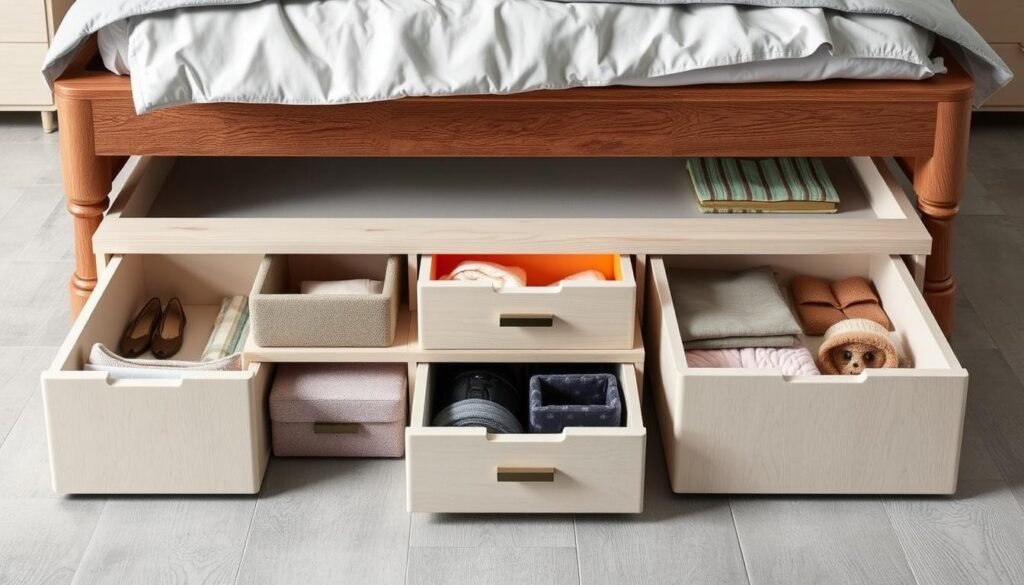
Clothing Organization Without a Closet
Many tiny homes aren’t able to accommodate closet space for clothes. However, you can still keep your clothes organized and wrinkle-free without a traditional closet. Consider using a collection of clips to hang your tops, sweaters, scarves, and other clothing items, saving on tiny home storage space.
There are several alternatives to traditional closets that you can explore:
- Wall-mounted racks for a sleek and modern look
- Freestanding wardrobes that can be easily moved around
- Ceiling-hung solutions to maximize vertical space
Creating a capsule wardrobe can also help reduce clutter and make the most of your limited storage space. Organize your clothes by category and frequency of use to ensure maximum efficiency.
To maintain a visually appealing clothing storage system, consider integrating your clothing storage with other bedroom elements for a cohesive design approach. You can also rotate your clothes seasonally to make the most of your limited storage space.
Defining Spaces Without Walls
In tiny homes, the lack of walls doesn’t have to mean a lack of defined spaces. You can create separate areas for living, working, and relaxing without sacrificing the openness that makes tiny homes feel cozy.
Using Rugs to Create Visual Boundaries
One effective way to define different spaces within your tiny home is by using rugs. A rug can visually demarcate an area, such as a living room or a workspace, and add warmth underfoot. Choose rugs with distinct colors or patterns to differentiate between spaces.
Room Dividers That Don’t Overwhelm
Room dividers are another excellent solution for creating separation without the permanence of walls. They come in various styles, from folding screens to hanging panels and open shelving units. When selecting a room divider, consider the balance between separation and openness. You want to define your spaces without making your home feel cramped or fragmented.
Different types of room dividers can serve multiple purposes. For instance, a shelving unit can act as a divider while providing storage or displaying decorative items. This multifunctionality is key to maximizing space in a tiny home.
Strategic placement of dividers is crucial. You should place them in a way that maximizes their effectiveness without disrupting the traffic flow within your home. Consider the path people will take through the space and position dividers to guide movement naturally.
Semi-transparent dividers can be particularly useful as they maintain light flow while still creating distinct zones. Materials like glass, mesh, or semi-transparent fabrics can help achieve this balance.
Using plants as living dividers is another innovative approach. Not only do they add a natural touch to your decor, but they also provide the benefits of biophilia, enhancing your well-being. Choose plants with varying heights and textures to create a visually appealing divider.
When selecting room dividers or any element to define your spaces, ensure they complement your overall design aesthetic. The goal is to enhance your home’s functionality and look, not to compete with it.
Decluttering Strategies for Tiny Home Living
Decluttering is not just about getting rid of items; it’s about creating a system that works for your tiny home. Effective decluttering strategies can make a significant difference in maintaining a comfortable and functional living space. By implementing the right techniques, you can ensure that your tiny home remains organized and clutter-free.
The 80/20 Rule: Keep Only What You Use
The 80/20 rule suggests that 80% of the time, you only use 20% of your belongings. Applying this principle to your tiny home can help you decide what to keep and what to discard. Start by evaluating each item: if you haven’t used it in the past year, it’s likely you won’t miss it. This rule can be particularly useful when deciding how to organize your storage spaces.
Baskets and Organizers for Tidy Spaces
Baskets and organizers are essential tools for maintaining a tidy tiny home. They not only contain items but also create systems that prevent clutter from building up again. From drawer dividers to wall-mounted baskets, there are various types of organizers suited for different spaces and purposes.
When selecting organizers, it’s crucial to choose ones that complement your aesthetic while maximizing functionality. For instance, woven baskets can add a natural touch to your decor, while plastic bins can offer a more modern look. The key is to create categorized storage systems that make items easy to find and put away.
Right-sizing organizers to fit both the items they’ll contain and the space they’ll occupy is also vital. Oversized organizers can overwhelm a small space, while too-small ones might not provide enough storage. Visible organizers, when chosen thoughtfully, can become part of your decor, adding to the overall ambiance of your tiny home.
To maintain organized systems, establish habits such as regular tidying and designated place for each item. Labeling and categorizing organizers in a way that works for all household members can also help in keeping the space organized. For example, using clear labels on drawers and baskets can make it easier for everyone to find what they need.
By incorporating these decluttering strategies and utilizing baskets and organizers effectively, you can create a more livable and enjoyable tiny home. Remember, the goal is to create a system that is not only functional but also reflects your personal style, making your tiny home a comfortable place to live.
Small Kitchen Countertop Extenders
In small kitchens, every inch counts, and that’s where innovative countertop solutions come into play. Countertop extenders can significantly enhance your kitchen’s functionality by providing additional space for food preparation, cooking, and even dining.
Cutting Board Inserts Over the Sink
A cutting board insert over the sink is a practical solution that expands your counter space while keeping your sink area functional. It allows you to prep ingredients right over the sink, making cleanup easier.
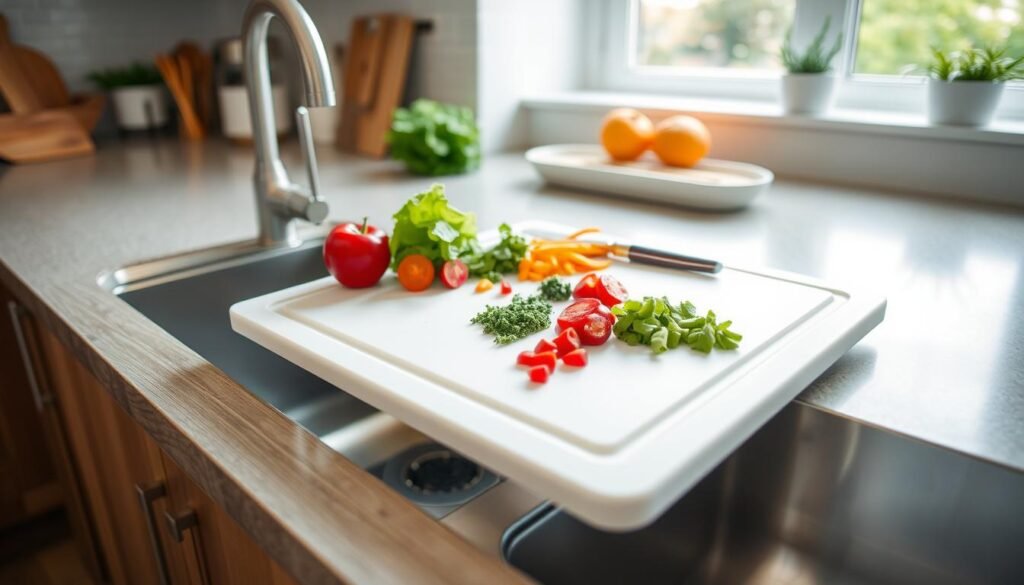
Rolling Kitchen Islands for Extra Workspace
Rolling kitchen islands offer flexibility and additional counter space exactly where you need it. They come in various sizes and styles, from compact carts to substantial butcher blocks with storage, making them ideal for tiny kitchens.
When selecting a rolling island, consider the size that can be easily maneuvered in your kitchen. Look for islands with storage features to maximize their functionality. These islands can also serve multiple purposes, such as a bar cart or additional dining space.
To maintain open floor space, consider the storage options for your rolling island when not in use. Choose an island that complements your kitchen design while providing maximum utility.
Personal Touches Without the Clutter
Personalizing a small space is all about striking the right balance between style and simplicity. You want to make your tiny home feel welcoming and truly yours without cluttering it.
Statement Pieces vs. Multiple Small Decorations
When it comes to decorating a small space, one effective strategy is to opt for a few statement pieces rather than numerous small decorations. A single, striking piece can add character to your space without overwhelming it.
For instance, a bold piece of artwork or a unique sculpture can become a focal point in your living room, drawing the eye and sparking conversation. This approach not only reduces clutter but also creates a sense of elegance and sophistication.
Plants as Space-Enhancing Decor
Plants! They add warmth and life to your tiny home without taking up much space. Not only do they bring in a natural touch, but they also improve air quality, making your living space healthier and more comfortable.
When choosing plants for your small space, consider the lighting conditions. For low-light areas, plants like Chinese Evergreen or Pothos are excellent choices. If your space is brighter, succulents or air plants can thrive.
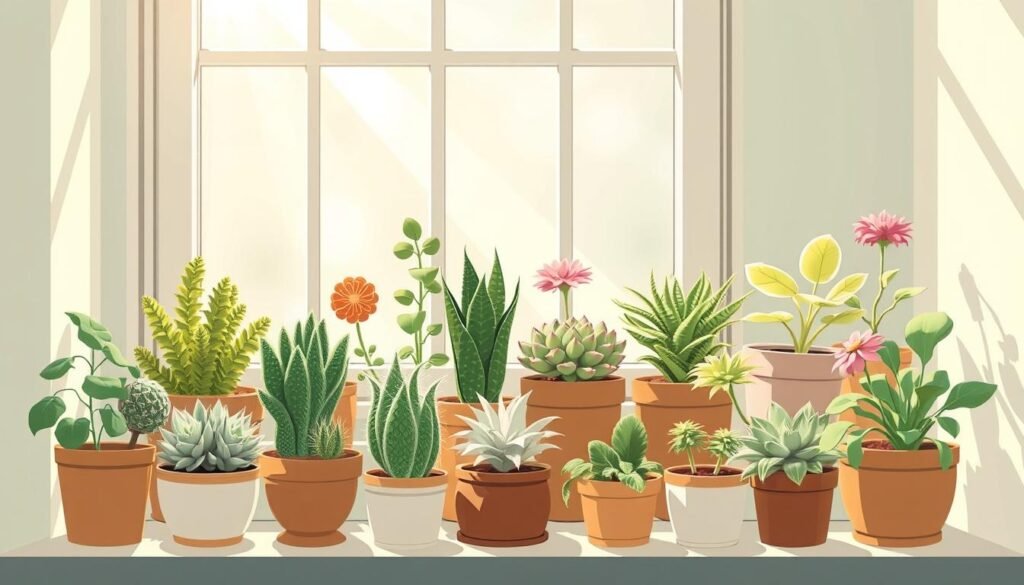
To maximize space, consider vertical gardening or using hanging planters. These options not only save floor space but also add a decorative element to your walls. For low-maintenance options, look into plants like Snake Plants or ZZ Plants, which are forgiving if you forget to water them from time to time.
Plants can also help define different zones within your tiny home or create a sense of privacy without solid barriers. By placing plants strategically, you can create a natural flow and separation between areas.
To maintain a cohesive look, choose plants with similar textures or colors. This will help create a sense of continuity throughout your space, making it feel more spacious and connected.
Conclusion: Living Large in a Small Space
Tiny homes may be small, but they hold immense potential for innovative living and space utilization. With the right strategies, you can transform your compact home into a chic, functional, and spacious haven.
The key principles of successful tiny home living revolve around multi-functional furniture, vertical storage, strategic mirror placement, and decluttering. By implementing these hacks, you can create a small space that feels larger than it is.
It’s all about being intentional with your space and possessions. By choosing statement pieces over clutter, utilizing foldable furniture, and optimizing storage, you can achieve a harmonious balance between comfort, style, and functionality.
For more inspiration on transforming your home, check out our article on 20 Cute Small Front Porch Ideas to enhance your outdoor space and create a seamless transition between indoors and outdoors.
Embracing tiny home living is a journey of adaptation and refinement. By applying even a few of these genius decor hacks, you can make a significant difference in how your home feels and functions. So, view your small space as an opportunity for innovation, and get ready to live large in your tiny home!
editor's pick
latest video
news via inbox
Nulla turp dis cursus. Integer liberos euismod pretium faucibua

